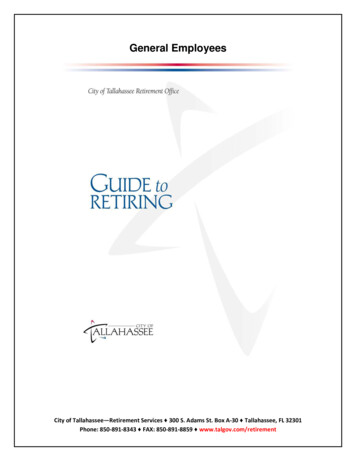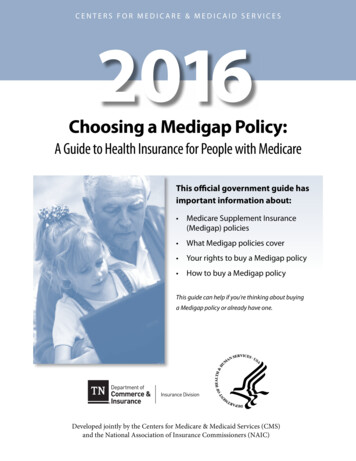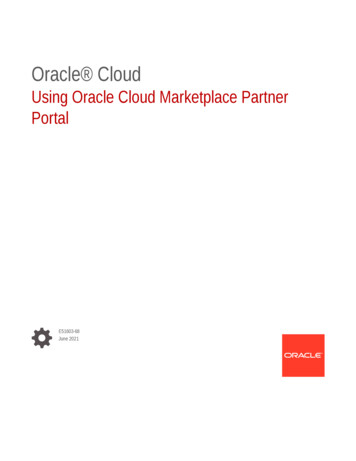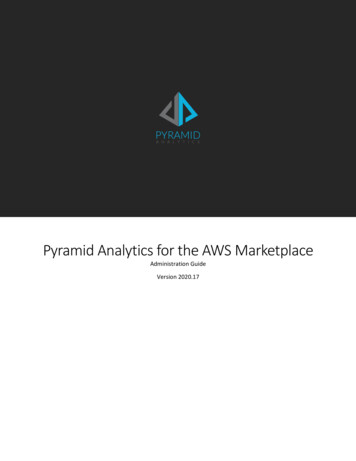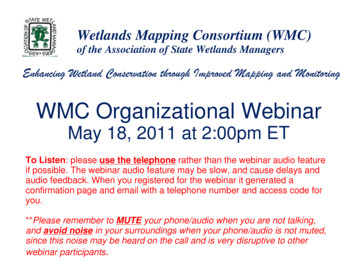
Transcription
From Marketplace to MedicareSeptember 2021This communication was printed, published, or produced anddisseminated at U.S. taxpayer expense. The contents of thisdocument do not have the force and effect of law and are not meantto bind the public in any way, unless specifically incorporated into acontract. This document is intended only to provide clarity to thepublic regarding existing requirements under the law. Thispresentation summarizes policy and operations current as of the dateit was presented. Links to certain course documents have beenprovided for reference. We encourage audience members to refer tothe applicable statutes, regulations, and interpretive materials forcomplete and current information about the requirements that applyto them.CSG-202109
Agenda Background on Medicare Automatic versus active enrollment Premium and premium-free Medicare Part A effective dates How to end or make changes to Marketplace coverage Medicare Periodic Data Matching (PDM) Medicare and eligibility for financial assistance through theMarketplace Scenarios2
What is Medicare? Medicare is a federal health coverage program for: People 65 or older, People under 65 with certain disabilities, and People of any age with End-stage Renal Disease (ERSD) (permanent kidneyfailure requiring dialysis or a kidney transplant).3
What is Medicare? (Cont.) There are four different parts ofMedicare: Medicare Part A (Hospital Insurance) –minimum essential coverage (MEC)* Medicare Part B (Medical Insurance) Medicare Part C (Medicare AdvantagePlans) – MEC* Medicare Part D (Prescription DrugCoverage)4
Understanding Medicare Part A(Hospital Insurance) Medicare Part A coverage includes: Hospital care Skilled care in a nursing facility Hospice Home health services for homeboundindividuals who require skilled services,observation, or education Part A is considered MEC5
Understanding Medicare Part B(Medical Insurance) Part B covers many services in two main categories: Medically necessary items and services: Services or supplies that are neededto diagnose or treat your medical condition and that meet acceptedstandards of medical practice. Preventive services: Health care to prevent illness (like the flu) or detect it atan early stage when treatment is most likely to work best. Medicare Part B covers medically necessary services, like outpatientdoctor visits, ambulance services, durable medical equipment, and otherbenefit categories. Part B is NOT considered MEC.6
How Much Does Part B Cost? Consumers will need to pay a premium for Part B. In 2021, most consumers will paythe standard monthly premium amount, which is 148.50 per month. If your modified adjusted gross income (MAGI) as reported on your IRS tax return fromtwo years ago is above a certain amount, you may pay an Income-related MonthlyAdjustment Amount (IRMAA) in addition to the standard monthly premium amountfor Part B. (You may also pay an IRMAA in addition to the monthly premium if youenroll in a Part D plan.) For more information on IRMAA, including how much you might owe based on yourMAGI, consumers can visit -blate-enrollment-penalty. Many consumers may be eligible for assistance with paying the Part B premiumthrough the Medicare Savings Programs (MSPs). In addition, the programs may coverdeductibles, coinsurance, and copayments if you meet certain conditions. For moreinformation, visit osts/medicaresavings-programs.7
Medicare Part C (Medicare Advantage Plans)and Part D (Prescription Drug Coverage) Qualifying private insurance companies andHMOs may elect to contract with CMS toprovide Medicare benefits through MedicareAdvantage (MA) plans. All MA plans providePart A (Hospital Insurance) and Part B(Medical Insurance). Most MA plans also provide Part D, orprescription drug benefits. Most plans offerextra benefits that Original Medicaredoesn’t cover – like some routine exams andvision, hearing, and dental services.8
How Consumers Enroll in Medicare Part A:Automatic vs. Manual Enrollment Enrollment in Medicare Part A isautomatic for people who: Turn 65 and have already been getting SocialSecurity benefits (SSB) or Railroad RetirementBoard (RRB) benefits for at least four monthsprior to their 65th birthday. Are under age 65 and have been getting SocialSecurity disability benefits or RRB disabilitybenefits for 24 months. Have amyotrophic lateral sclerosis (ALS) andhave been getting Social Security disabilitybenefits or RRB disability benefits.9
How Consumers Enroll in Medicare Part A:Automatic vs. Manual Enrollment (Cont.) Groups that must actively (manually) apply to enroll into Medicare Parts A and Binclude: Those who aren’t getting SSB or RRB benefits for at least four months prior to their65th birthday. Those who have ESRD and get a regular course of dialysis or a kidney transplant.* Those who must pay a premium for Medicare Part A (those not eligible for premiumfree Medicare Part A). If you live in Puerto Rico, you’re signed up for Part A automatically if you get SSBor RRB benefits. You must sign up for Part B manually.*Note: Eligibility for Medicare coverage based on ESRD works differently than other types ofMedicare eligibility. If you’re eligible for Medicare based on ESRD and don’t sign up rightaway, your coverage could start up to 12 months before the month you apply. For moreinformation, visit enal-disease-esrd.10
Knowledge Check #1Which of these qualifies a consumer for automatic enrollment intoMedicare Parts A and B?A. A consumer who has ESRD and is getting regular treatment.B. A consumer who must pay a premium for Medicare Part A.C.A consumer who is over age 65 and isn’t getting SSB.D. A consumer who is age 65 and has been getting SSB for at least four monthsprior to their 65th birthday.11
Knowledge Check #1 AnswerWhich of these qualifies a consumer for automatic enrollment intoMedicare Parts A and B?A. A consumer who has ESRD and is getting regular treatment.B. A consumer who must pay a premium for Medicare Part A.C.A consumer who is over age 65 and isn’t getting SSB.D. A consumer who is age 65 and has been getting SSB for at least four monthsprior to their 65th birthday.12
How Consumers Enroll in Medicare:Automatic Enrollment If automatically enrolled, the consumer will get aMedicare card in the mail three months before their65th birthday. Medicare Part A and Part B coverage usually begins onthe first day of the month the consumer turns 65.13
How Consumers Enroll in Medicare:Active (“Manual”) Enrollment Consumers can sign up with Social Securityby: Visiting SSA.gov/benefits/medicare. Calling Social Security at 1-800-7721213 (TTY: 1-800-325-0778). Contacting a local Social Security office. If a consumer or their spouse worked for a railroad, they can call the RRB at1-877-772-5772 (TTY: 312-751-4701). Assisters can refer clients to a local State Health Insurance AssistanceProgram (SHIP) for more help with Medicare eligibility and enrollment andinformation about Medicare benefits (Shiphelp.org).14
Who Qualifies for Premium-freeMedicare Part A? Consumers can get premium-free Medicare Part A at 65 or older if: They or their spouse worked for the equivalent of 10 years, either consecutively or nonconsecutively, at jobs where they paid Medicare taxes. They’re already getting (or are eligible to get) benefits from Social Security or the RRB. They or their spouse had Medicare-qualified government employment. Consumers can get premium-free Medicare Part A before age 65 if: They got SS or RRB disability benefits for 24 months or have ALS and are getting SS or RRBdisability benefits. They have ESRD and meet other specific requirements.15
The Medicare Initial Enrollment Period For consumers who are eligible for Medicare based on turningage 65, the Initial Enrollment Period (IEP) to sign up for MedicarePart A and for Medicare Part B, if not automatically enrolled, isseven months long. Consumers who must actively sign up for Medicare areencouraged to sign up as soon as possible during their IEP. Most consumers have to wait until Medicare’s GeneralEnrollment Period (GEP) or qualify for a Special EnrollmentPeriod (SEP) if they do not enroll during their IEP. In addition topotential gaps in coverage, these consumers may also be subjectto a monthly late enrollment penalty that may be required aslong as the consumer has Part B.16
The Medicare Initial Enrollment Period(Cont.) The IEP begins three months beforethe consumer’s 65th birthday, themonth they turn 65, and ends threemonths after their 65th birthday.*Note: If the consumer’s birthday fallson the first of the month, their IEPstarts four months prior to their 65thbirthday.17
When Does Premium-free MedicarePart A Coverage Start? For people automatically enrolled, coverage starts the first of the month theyturn 65. If their birthday is on the first of the month, coverage starts a monthearlier -- the month before they turn 65. Consumers who are turning 65 and must actively sign up for their premium-freePart A can sign up any time after their IEP begins.If you sign up for Part A (if you have tobuy it) in this month:Your coverage starts:The month you turn 65One month after you sign upOne month after you turn 65Two months after you sign upTwo months after you turn 65Three months after you sign upThree months after you turn 65Three months after you sign up18
When Does Premium-free MedicarePart A Coverage Start? (Cont.) If consumers sign up after their IEP hasended, their Premium-free Part Acoverage start date will go back(retroactively) up to six months fromwhen they submit the application forMedicare Part A, but no earlier than thefirst day of the month they turn 65, orthe month before they turn 65 if theirbirthday is the first of the month.19
When Does Premium-free MedicarePart A Coverage Start? (Cont.) Consumers who are newly eligible for or enrolled in premium-free Medicare Part Ashould report this change as soon as possible to the Marketplace and either end theirMarketplace coverage or, if they choose, remain in their Marketplace plan. Once consumers are considered eligible for or enrolled in premium-free MedicarePart A, they’ll no longer be eligible for any premium tax credits or other cost savingsthey may be getting for their Marketplace plan. Consumers considered eligible for orenrolled in Medicare Part A will have to pay full price for the Marketplace plan. Generally, individuals getting advance payments of the premium tax credit (APTC)while dually enrolled in coverage through the Marketplace and Medicare may have topay back all or some of the APTC received for months the individual was enrolled inboth Marketplace coverage with APTC and Medicare Part A when they file theirfederal income tax return. However, due to the changes to tax reconciliation in theAmerican Rescue Plan (ARP) Act, individuals aren’t required to repay excess APTC forthe 2020 federal income tax year.20
Knowledge Check #2Fill in the blank: Premium Medicare Part A or Premium-free Medicare Part AConsumers who are considered eligible for or enrolled inare no longer eligible to get financial assistance for their current Marketplace plan.Consumers are encouraged to compare their Medicare benefits and costs with theircurrent Marketplace plan (understanding they’ll be responsible for the full cost oftheir Marketplace plan premium). Consumers who don’t enroll in Medicare Part Bduring their initial IEP but enroll after their IEP has ended may incur a penalty forthe duration of the time they’re enrolled in Medicare Part B.21
Knowledge Check #2 AnswerFill in the blank: Premium Medicare Part A or Premium-free Medicare Part AConsumers who are considered eligible for or enrolled in Premium-free MedicarePart A are no longer eligible to get financial assistance for their current Marketplaceplan. Consumers are encouraged to compare their Medicare benefits and costs withtheir current Marketplace plan (understanding they’ll be responsible for the fullcost of their Marketplace plan premium). Consumers who don’t enroll in MedicarePart B during their initial IEP but enroll after their IEP has ended may incur a penaltyfor the duration of the time they’re enrolled in Medicare Part B.22
When Can Consumers Sign Up forPremium Part A? Consumers who are eligible for premium Part A must decide ifthey want to enroll and pay premiums for Part A. If they decideto do so, they must sign up during their IEP. Otherwise, theymay have to wait until the Medicare GEP or qualify for an SEPto sign up. The Medicare GEP begins in January and ends in March, withcoverage beginning July 1. SEPs for Medicare aren’t the same as SEPs for the Marketplace. Terminating Marketplace coverage doesn’t result in an SEP toenroll in Medicare. If these consumers don’t enroll during their IEP, they could facelate enrollment penalties that make Medicare premiums moreexpensive for as long as they are enrolled in Medicare.23
Premium Medicare Part A and Part BEffective Dates*This SEP can only be used once the individual IEP is over.24
Why Consumers Should Set a Date toEnd Their Marketplace Coverage To avoid paying double premiums for overlapping coverage (in the Marketplaceand Medicare) since Marketplace coverage duplicates the coverage you arereceiving through Medicare. To avoid gaps in coverage. To prevent unintentionally ending coverage for other members on theMarketplace plan. To avoid having to pay back all or some of the APTC they may have incorrectlyreceived while eligible for or enrolled in Medicare.25
When Consumers Should EndMarketplace Coverage Consumers should end their Marketplace plan the day before theirMedicare coverage begins. Consumers should select the date theywant to end coverage. Generally, they can set a date for theirMarketplace coverage to end. For more instructions on how to time ending Marketplace coverageand signing up for Medicare, lace-to-medicare.26
How Consumers Should EndMarketplace Coverage Most consumers will want to end Marketplace coverage when they becomeeligible for Medicare or when they know their Medicare start date. In some cases, consumers will need to end their Marketplace coverage bycalling the Marketplace Call Center. In other cases, consumers can end their coverage on HealthCare.gov. This depends on: If everyone on the application is ending their coverage, or just some people; and If the person who is ending their Marketplace coverage is the household contact(subscriber) on the application. There may be circumstances when the person whois ending their Marketplace coverage is the household contact under which otherenrollees in that person’s coverage who want to continue their coverage will needto select the same or a new plan and may have their accumulators (such asdeductible or annual limit on cost sharing) reset.27
How Consumers Should EndMarketplace Coverage (Cont.) When the person transitioning from Marketplace coverage to Medicare isthe household contact, they should call the Marketplace Call Center to: End the household contact’s Marketplace coverage. Designate a new household contact. Ensure that those remaining on their Marketplace plan don’t lose theircoverage.*Note: Don’t try to change or remove the household contact online unlessyou’re ending coverage for everyone on the plan.28
Complex Case Scenario #1 Beth is married to John, who is 63. Their daughter Mary, 24, is a dependentenrolled on the same Marketplace plan as herparents. Beth would like to enroll in Medicare but isconfused about how to end her Marketplacecoverage. She tried to end her coverage onlinebut isn’t sure if she followed the processcorrectly.29
Points to Discuss and Helpful Tips To avoid a gap in coverage, Beth shouldn’t terminate herMarketplace plan before her Medicare coverage starts. Once Bethknows when her Medicare coverage starts, she can end herMarketplace plan. Beth shouldn’t try to change or end Marketplace coverage onlineunless she wants to end coverage for everyone on the plan. Endingher coverage by phone instead ensures Beth, who wants to endher coverage, gets the desired termination date for herself andensures that other enrollees in the Marketplace plan can continueto have Marketplace coverage. Beth should therefore contact the Marketplace Call Center forassistance.30
Applicable Rules If you’re enrolled in a Marketplace plan first and then become eligiblefor premium-free or enrolled in premium-free or premium Medicare,you can choose to remain enrolled in your Marketplace plan at leastthrough the end of the plan year. But there are important considerations: Once you become eligible for or enrolled in Medicare Part A, you are nolonger eligible for APTC or cost-sharing reductions (CSRs) and may haveto pay back some or all of the APTC you receiving during months ofoverlapping coverage. You’ll pay for duplicative coverage. Medicare doesn’t coordinate benefits with Marketplace plans. If you choose to terminate your Marketplace plan, pay close attention todisenrollment timeframes.31
Medicare Periodic Data Matching:Notices to Dually Enrolled Consumers The Marketplace sends Medicare Periodic Data Matching (PDM) notices toconsumers who may be dually enrolled in Medicare that is MEC (referred to as MECMedicare) and Marketplace coverage with APTC and CSRs. Medicare Part A is MECMedicare. Notices are uploaded to the consumer’s My Account or mailed via the U.S.Postal Service, depending on the consumer’s stated preference. Medicare PDM notices include: Name(s) of consumer(s) found to be dually enrolled. A recommendation that individuals found to be enrolled in MEC Medicare and aMarketplace plan should end their Marketplace coverage. Consequences of dual enrollment, including paying for coverage that is duplicative toMedicare and potential for late enrollment penalties if the consumer doesn’t sign up forMedicare Part B when they are supposed to. Instructions on how to end Marketplace coverage or Marketplace financial assistance. Where to find contact information to confirm if they’re enrolled or if they have any questions32about Medicare.
Medicare PDM (Cont.) Medicare PDM process updates occurred in 2019. Applicants have the option to providewritten consent for the Marketplace to end their Marketplace coverage if they’re laterfound to be enrolled in Medicare through the Medicare PDM process through anattestation question on the Marketplace application.33
Medicare PDM Process If you have both Medicare Part A and a Marketplace plan with APTCand CSRs, and you receive a Medicare PDM initial warning notice,you have 30 days from receipt of the Medicare PDM initial warningnotice to return to the Marketplace to either end: APTC and CSRs, or Your Marketplace plan, if you so choose. You’ll get specific instructions in your Medicare PDM notice basedon your Medicare enrollment status. You’ll also have the option to: Disagree with the results of the Medicare PDM notice and providedocumentation if you think you aren’t enrolled in Medicare Part A; or Change your attestation response from agree to disagree if you nolonger want the Marketplace to end your coverage.34
Medicare PDM Process (Cont.) If you don’t take any action after the 30-dayperiod ends, the Marketplace will either: End APTC and CSRs, or End Marketplace coverage (if you provided writtenconsent for the Marketplace to act on your behalf andend your Marketplace coverage if found at a laterdate to be enrolled in both Medicare and theMarketplace). The rules around eligibility for Medicare Part Aand APTC differ depending on if the consumermust pay a premium for Medicare Part A andwhen they sign up.35
Eligibility for APTC for Consumers withPremium-free Medicare Part A For consumers automatically enrolled in premium-free MedicarePart A: These consumers are generally no longer eligible for financialassistance through the Marketplace the first day of the month theyturn 65. For consumers who must sign up for premium-free Medicare PartA: These consumers are no longer eligible for financial assistancethrough the Marketplace starting the first day of the first full monththey can start using their Medicare coverage.36
Eligibility for APTC for Consumers withPremium Medicare Part A Consumers who must pay a premium for their Medicare Part A wouldremain eligible for financial assistance through the Marketplace, unlessand until they sign up for and can start using their Medicare coverage,assuming they are otherwise eligible. If they sign up for Medicare coverage, they’d no longer be eligible forfinancial assistance through the Marketplace the month their Medicarecoverage actually begins (refer to the effective date chart). These Medicare consumers may face late enrollment penalties or a gap incoverage if they sign up after their IEP ends.37
Eligibility for APTC for Consumers withPremium Medicare Part A (Cont.) These consumers should compare their benefits and total premiums underMedicare with their Marketplace plan. But, in most cases, your Medicare Part Apremium will cost less than your Marketplace premium without financial help.Many individuals may be eligible for assistance with paying premiums for Part Aand B through MSPs. In addition, the programs may cover deductibles, coinsurance, and copayments ifyou meet certain conditions. For more information, visit sts/medicare-savings-programs#collapse-2614.38
Complex Case Scenario #2: PaulPaul turns 65 on June 1, is eligible for premium-freeMedicare Part A, and enrolls He currently has a Marketplace plan with APTC for apremium of 75.00 a month. Paul is eligible for premium-free Medicare Part A. He must actively enroll in Medicare coverage. His IEP began March 1. He enrolls mid-July, during his IEP.Is Paul still eligible for APTC?39
Complex Case Scenario #2: Paul(Cont.)Paul turns 65 on June 1, is eligible for premium-free Medicare PartA, and enrolls (cont.) Paul is also considering Part B enrollment. Paul’s premium for Medicare Part B is 144.60, which appearshigher than his premium for his Marketplace plan with APTC. Part A is hospital insurance and isn’t FULL medical coverage. Part Bis medical insurance for physician’s services, certain preventiveservices, and other types of outpatient care. Paul loses APTC eligibility based on his eligibility for premium-freePart A hospital insurance whether he enrolls in Part B or not. If Paul doesn’t sign up for Part B during his IEP, he may be subject tolate enrollment penalties for the lifetime of his Medicare Part Bcoverage.40
Complex Case Scenario #2: Paul(Cont.)Paul turns 65 on June 1, is eligible for premium-free Medicare Part A,and enrolls (cont.) Paul signs up for Medicare Parts A and B in mid-July. His premium-free Medicare Part A coverage would start retroactively to thefirst day of the month that he turned 65 – June 1. Paul would no longer be eligible for APTC on August 1, the first day of themonth after he signs up for Medicare.41
Complex Case Scenario #2: Paul(Cont.)Paul turns 65 on June 1, is eligible for premium-free MedicarePart A, and enrolls (cont.) When Paul signs up for Medicare Part B in mid-July, his effectivedate will be in September. Paul should consider signing up for Part B in any of the threemonths before he turns 65 so that his Part B coverage will beeffective on June 1 with his Part A. Even if Paul has Marketplace coverage, he should enroll inMedicare when first eligible to avoid the risk of a delay inMedicare coverage and the possibility of a Medicare lateenrollment penalty.42
Complex Case Scenario #3: SallySally turns 65 on June 3, is eligible for premium-free MedicarePart A, and doesn’t enroll Sally has a Marketplace plan with APTC. Sally qualifies for premium-free Medicare Part A. She must actively enroll in Medicare coverage. Her IEP has begun. She doesn’t want to enroll in Medicare; she wants to keepher Marketplace coverage.Is Sally still eligible for APTC?43
Complex Case Scenario #3: Sally(Cont.)Sally turns 65 on June 3, is eligible for premium-free Medicare Part A, anddoesn’t enroll (cont.) Sally chooses not to sign up for Medicare and is not automatically enrolled. For purposes of APTC eligibility, Sally will be considered “eligible” for Medicarebenefits on October 1, the first day of the first full month after her IEP ends. Sally will lose eligibility for APTC beginning October 1. She will need to return to the Marketplace and report she’s now eligible forMedicare so that she will no longer get APTC. If Sally doesn’t report herMedicare eligibility, she may have to pay back any APTCs beginning October 1. Sally will pay the full price of her Marketplace plan starting October 1.*Note: The scenario above describes the normal process. Due to the ARP, theIRS confirmed that for tax year 2020 only, consumers won’t be liable to payback excess APTC.44
Complex Case Scenario #4: HannahScenario: Hannah is eligible for premium Medicare Part Aand recently signed up for Medicare Part A and Part B Hannah signed up for Medicare Part A and Part B inSeptember, the last month of her IEP. Her Medicare coverage (both Part A and Part B) begins threemonths after she signs up, on December 1. Hannah’s eligibility for APTC would end December 1, when shestarts getting Medicare Part A coverage.45
Medicare and Eligibility for APTCYesThe consumer iseligible forPremium-freeMedicare Part A.Does theconsumerenroll intoMedicare(duringtheir IEP)?YesNoIs the consumercurrently enrolledin a MarketplacePlan with APTC?YesThe consumer iseligible forPremiumMedicare Part A.Does theconsumerenroll intoMedicare(duringtheir IEP)?YesNoConsumer’s eligibility for APTC will enda month after application is processedby Medicare.Consumer’s eligibility for APTC endsthe month after their IEP ends.Consumer’s eligibility for APTC will endonce Medicare benefits begin.Consumer may keep Marketplace Planwith APTC if they don’t enroll intoMedicare and receive benefits.If they later apply, APTC eligibilitywould end. Late enrollment penaltiesmay apply if they later decide to enrollinto Medicare.46
Medicare and Eligibility for APTC(Cont.) In December 2019, CMS started a new monthly mailing to all Marketplace enrollees whowill turn 65 within the next month to notify them of the important decisions related toMedicare enrollment. Letters are available in both English and Spanish: English: for-consumers-turning65.pdf. Spanish: for-consumers-turning65-spanish.pdf.47
SHIP Resources Assisters should encourage consumers to reach out to their local SHIP counselorfor assistance. SHIPs provide local, in-depth, and objective insurance counselingand help to Medicare-eligible individuals, their households, and caregivers. For more information visit Shiphelp.org.48
Other Resources Step-by-step instructions: How & when to cancel your Marketplace plan and enroll in ketplace-to-medicare Premium-free versus premium Medicare Part A: -a-costs How consumers should sign up for Medicare Parts A & B: medicare Information on Medicare Savings Programs: osts/medicaresavings-programs Transitioning from Marketplace to Medicare: .pdf Frequently Asked Questions on the relationship between Medicare and Marketplace Marketplace Master FAQ 4-28-16 v2.pdf The late enrollment penalty for delaying enrollment in Medicare Part B: b-late-enrollment-penalty Medicare Periodic Data Matching (PDM) Frequently Asked Questions (FAQ): medicare-periodic-data-matching-faq.pdf Medicare & You Handbook: Medicare.gov/Pubs/pdf/10050-Medicare-and-You.pdf49
Medicare Part C (Medicare Advantage Plans) and Part D (Prescription Drug Coverage) Qualifying private insurance companies and HMOs may elect to contract with CMS to provide Medicare benefits through Medicare Advantage (MA) plans. All MA plans provide Part A (Hospital Insurance) and Part B (Medical Insurance).
